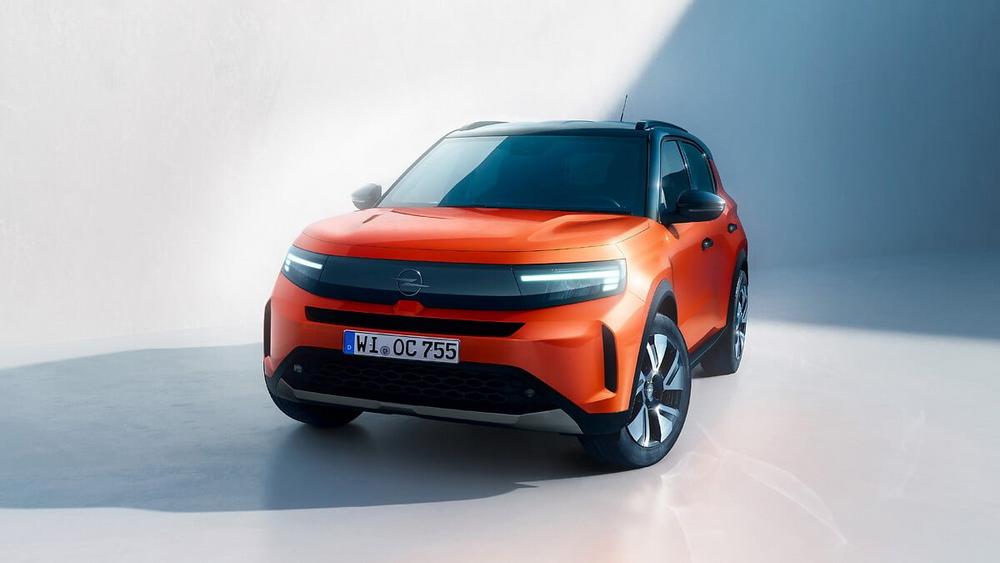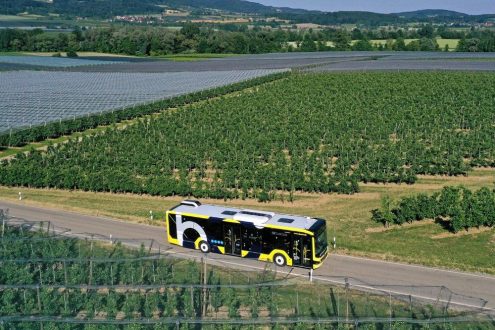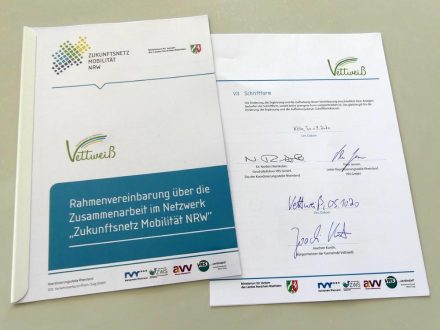
Practical, Efficient, Electrified: The New Opel Hybrids With 48-Volt Technology
- Wide selection: Opel passenger cars from Corsa to Astra, Mokka and Grandland to the new Frontera can already be ordered with an efficient hybrid drive
- Hybrid advantage: CO2 emissions and consumption decrease, purely electric at low speeds
- Perfect coordination: Seamless interaction between combustion engine and 21 kW electric motor plus electrified six-speed dual clutch transmission
- Everything at a glance: Practical hybrid information clearly arranged in the driver information display
Combined values for Opel Astra Hybrid according to WLTP1: fuel consumption 5.0 l/100 km, CO2 emissions 113 g/km; CO2 label: C.
Combined values for Opel Astra Sports Tourer Hybrid according to WLTP1: fuel consumption 5.1 l/100 km, CO2 emissions 115 g/km; CO2 label: C.
Combined values for Opel Corsa Hybrid according to WLTP1: fuel consumption 4.6-4.7 l/100 km, CO2 emissions 104-106 g/km; CO2 label: C.
Combined values for Opel Frontera Hybrid according to WLTP1: fuel consumption 5.5 l/100 km, CO2 emissions 122-126 g/km; CO2 label: D.
Combined values for Opel Grandland Hybrid with 100 kW (136 hp) according to WLTP1: fuel consumption 5.7 l/100 km, CO2 emissions 128 g/km; CO2 label: D.
Combined values for Opel Mokka Hybrid according to WLTP1: fuel consumption 4.9 l/100 km, CO2 emissions 110 g/km; CO2 label: C.
Rüsselsheim. Driving electrified and saving fuel without having to change driving and operating habits or having to connect the car to a charging point: the new Opel models with 48-volt hybrid technology make all this possible. The latest addition is the efficient Opel Frontera Hybrid. The affordable new family-friendly SUV can already be ordered with 48-volt technology. For prices starting at €23,900 euros (all prices RRP including VAT in Germany), the Frontera Hybrid comes with a 74 kW (100 hp) 1.2-litre turbocharged petrol engine developed specifically for hybrid use. It works in conjunction with a 21 kW (28 hp) electric motor and an electrified six-speed dual clutch transmission, so that fuel consumption and CO2 emissions are significantly reduced compared to a comparable conventionally powered vehicle. From €25,700, the Frontera Hybrid is also available as a 100 kW (136 hp) turbo hybrid.
In addition, Opel customers can choose from many other models with the modern hybrid technology. The portfolio already extends from the small car bestseller Opel Corsa to the stylish Opel Mokka to the compact class successes Opel Astra and Astra Sports Tourer as well as the top-of-the-line Opel Grandland SUV.
Perfectly coordinated system: Save fuel and drive fully electrically at times
The clever, cost efficient and compact 48-volt hybrid technology offers many advantages in everyday use. It can be used to reduce fuel consumption and CO2 emissions by up to 18 percent (as with the Corsa) compared to a comparable combustion vehicle and at the same time increase driving comfort.
In everyday driving in the city and on country roads, the petrol engine and electric motor work together or separately depending on requirements – always in optimal harmony between energy consumption and performance. To ensure that the catalytic converter and brake assistant function optimally from the first tap on the accelerator pedal, the petrol engine is always used when starting the Opel models. The electric drive supports the petrol engine when accelerating and starting from a standstill. The electric motor contributes torque, especially at low engine speeds, which benefits driving dynamics and CO2 savings.
At low speeds, the electric motor also enables fully electric travel for up to one kilometre or up to 50 percent of the time used in the city – for example when manoeuvring. The vehicle automatically switches to electric drive when the battery charge, outside temperature and catalytic converter temperature are appropriate. If the Opel Hybrids decelerate at higher speeds and the petrol engine switches off, the electric motor acts as a generator to recharge the 48-volt battery of the hybrid system. At the same time, when the accelerator pedal is released, the hybrid can “sail” with the support of the electric motor.
Hybrid drivers can choose between the three driving modes Eco (for particularly efficient operation), Normal and Sport. In Sport mode, the petrol engine is always running to ensure the required performance at all times.
Driver information display with hybrid-specific information
Elsewhere, Opel Hybrid drivers can easily and conveniently keep an eye on the most important displays for the current operating mode, energy status and much more thanks to hybrid-specific information. The driver information display has the views familiar from the conventionally powered model variants – with a few special features. The numbers on the digital speed display are white when the petrol engine is running. If this switches off and the vehicle is operated purely electrically, the display changes to blue. The additional permanent power display (replacing the rev counter) in the driver information display is divided into:
- Power: The vehicle provides maximum power, the combustion engine and electric motor work at the same time.
- Eco: The vehicle is currently running with the best energy efficiency (petrol engine or electric motor).
- Charge: The vehicle is decelerating and recuperating energy.
When the driver brings up the energy flow display, a schematic representation of the vehicle appears in the driver information display showing the flow of energy between the battery, petrol engine and wheels as well as the charging status of the battery. The current operating status – 100 percent electric driving, energy recuperation or the power coming from the combustion engine – is displayed in different colours. When the vehicle is switched off, the trip summary display provides additional data such as the distance travelled, the duration of the journey, the average consumption, the remaining range and the percentage of the route driven purely electrically.
The main components and functions of the 48-volt hybrid system at a glance
- A new generation of three-cylinder, 1.2-litre petrol engines that have been specially developed for hybridisation and to meet the Euro 6e emissions standard. For optimum efficiency, the new engines operate in the Miller combustion cycle. This thermodynamic cycle is enabled by the variable geometry turbocharger, which enhances performance at low rpm, and variable valve timing.
- A new electrified six-speed dual clutch transmission that has also been designed especially for hybrid applications. The gear shifts without torque interruption are shorter and comfort is higher. The transmission casing also houses the electric motor and the DC inverter, optimising the size and weight of the drivetrain and ensuring that excellent driving performance is delivered.
- A permanent magnet synchronous electric motor, integrated in the gearbox, produces peak power of 21 kW (28 hp) and maximum torque of 55 Nm.
- A belt-driven starter (also 48-volt technology based) which – in combination with the electric motor – starts the petrol engine from a cold start. The belt-starter also restarts the engine quickly and seamlessly during the drive.
- A 48V lithium-ion battery with a useable capacity of 432 Wh (gross 890 Wh), which is recharged via recuperation and the petrol engine, usually installed under the front left seat (Grandland Hybrid: underbody). This location not only achieves optimum weight distribution for good driving dynamics but also allows the full volume of the boot to be retained.
- Two electrical networks. A low voltage 12V network supplying the car’s equipment (e.g. electric windows, infotainment system); and a 48V network to supply the hybrid system. A direct current converter to transfer electrical energy from the 48-volt to the 12-volt network is also included. If the 48-volt battery is almost empty – for example, after the car has been idle for a particularly long time – the converter can transfer energy for service purposes from the 12-volt to the 48-volt network.
[1] A vehicle’s values not only depend on the vehicle’s efficient use of fuel, but are also influenced by driving behaviour and other non-technical factors.
Opel Automobile GmbH
Bahnhofsplatz
65423 Rüsselsheim
Telefon: +49 (6142) 7-70
Telefax: +49 (6142) 77-8409
http://de-media.opel.com/de
Communications, Manager International Product
Telefon: +49 (6142) 69-22084
E-Mail: colin.yong@stellantis.com
Telefon: +49 (6142) 6927811
E-Mail: carina.elsinger@opel-vauxhall.com
![]()



